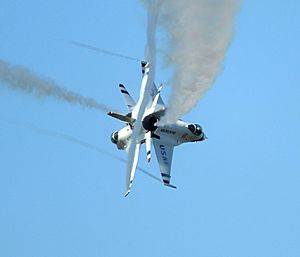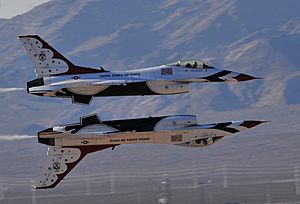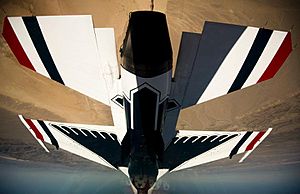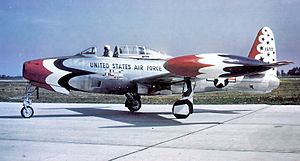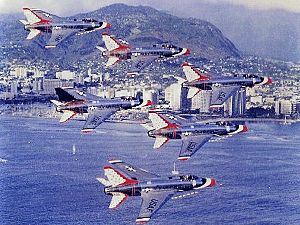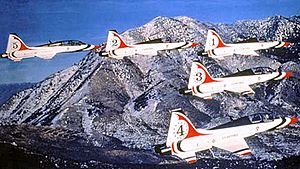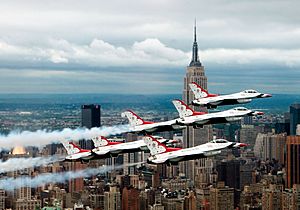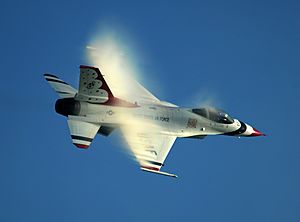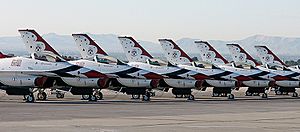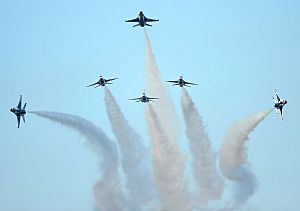United States Air Force Thunderbirds facts for kids
Quick facts for kids ThunderbirdsUSAF Air Demonstration Squadron |
|
|---|---|
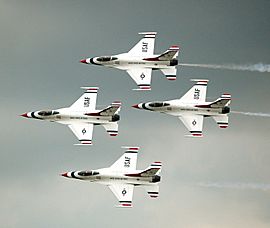
Diamond formation at the 2009 Dayton Air Show
|
|
| Active | 25 May 1953 – present (as air demonstration squadron) 13 June 1917 – 1 February 1963 (as operational squadron) |
| Country | |
| Branch | |
| Role | Aerobatic display team |
| Size | 12 officers 120 enlisted support personnel |
| Part of | Air Combat Command |
| Garrison/HQ | Nellis Air Force Base Las Vegas, Nevada |
| Colors | Red, White and Blue |
| Engagements | World War I World War II (Pacific Theater) Korean War |
| Insignia | |
| Identification symbol |
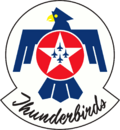 |
| Aircraft flown | |
| Fighter | six F-16C Fighting Falcons two F-16D Fighting Falcons |
The USAF Air Demonstration Squadron ("Thunderbirds") is the air demonstration squadron of the United States Air Force (USAF). The Thunderbirds are assigned to the 57th Wing, and are based at Nellis Air Force Base, Nevada. Created 71 years ago in 1953, the USAF Thunderbirds are the third-oldest formal flying aerobatic team (under the same name) in the world, after the French Air Force Patrouille de France formed in 1931 and the United States Navy Blue Angels formed in 1946.
The Thunderbirds Squadron tours the United States and much of the world, performing aerobatic formation and solo flying in specially marked aircraft. The squadron's name is taken from the legendary creature that appears in the mythologies of several indigenous North American cultures.
Overview
The Thunderbirds Squadron is a named USAF squadron, meaning it does not carry a numerical designation. It is also one of the oldest squadrons in the Air Force, its origins dating to the organization of the 30th Aero Squadron, formed at Kelly Field, Texas, on 13 June 1917.
Officers serve a two-year assignment with the squadron, while enlisted personnel serve three to four years. As the squadron performs no more than 88 air demonstrations each year, replacements must be trained for about half of the team each year, in order to provide a constant mix of experience. In addition to their air demonstration responsibilities, the Thunderbirds are part of the USAF combat force and if required, can be rapidly integrated into an operational fighter unit. Since 15 February 1974 the Thunderbirds have been a component of the 57th Wing at Nellis AFB. Since 1953, they have flown in front of more than 300 million people.
F-16 Fighting Falcon
The Thunderbirds perform aerial demonstrations in the F-16C Fighting Falcon, and they also fly two F-16D twin-seat trainers.
The F-16 has been the demonstration aircraft for the Thunderbirds since the 1983 season. In January 1982, four members of the squadron were killed in what became known as the "Diamond Crash" of T-38 Talon aircraft which the squadron had flown since 1974. Partially as a result of that accident, the squadron switched to the F-16A, and sat out the 1982 airshow season and spent that year retraining and transitioning over to the new aircraft to ready themselves for the 1983 season. The F-16, however, had been considered for transition prior to the accident. In rebuilding the Thunderbird Team, the Air Force recruited previous Thunderbird pilots, qualified each in the F-16A, and had them begin by flying "two-ship" maneuvers, then expanded the program one airplane at a time up to the full six airplanes. Beginning in June 1982, the F-16 Thunderbirds were led by Major Jim Latham.
The team continues to fly the F-16, having switched from the F-16A to the F-16C in 1992. Only a few minor modifications differentiate a Thunderbird from an operational F-16C. These include the replacement of the 20 mm cannon and ammunition drum with a smoke-generating system, including its plumbing and control switches, the removal of the jet fuel starter exhaust door, and the application of the Thunderbirds' glossy red, white, and blue polyurethane paint scheme. All the modification work is performed at the maintenance depot at Hill AFB near Ogden, Utah. Other than those modifications, the aircraft are taken from the standard USAF inventory as production fighters, and can be returned to an operational squadron in short order without any major modification.
- General Dynamics F-16A/B Fighting Falcon
- During the switch to the F-16A the Thunderbirds acquired new block 15 aircraft which they operated from 1983 to 1991, making the team one of the last USAF units flying the older F-16A's before transitioning into new C's. They also operated the two-seat F-16B during this time for training new pilots and for VIP flights, these being replaced by the F-16D when the rest of the squadron transitioned to the F-16C.
- Lockheed Martin F-16C/D Fighting Falcon (Block 32)
- The block 32H/J aircraft currently assigned to the Thunderbirds were built in 1986 and 1987, and operated by the Thunderbirds from 1992 to 2008. At their retirement, they were some of the oldest operational F-16s in the Air Force.
- Lockheed Martin F-16C/D Fighting Falcon (Block 52)
- In the 2009 show season the Thunderbirds transitioned to an updated version of the F-16 fighter. The Block 52s have an upgraded avionics package that brings the Thunderbird fleet into alignment with the rest of the worldwide F-16 fleet. Additionally, the more powerful Pratt & Whitney F100-PW-229 engine adds an additional 3,600 lbf of thrust. This in turn increases the maximum allowable gross weight for ground handling, taxi, takeoff and in-flight maneuvers by nearly 5,000 lb.
Support aircraft
- Boeing C-17 Globemaster III
Demonstration routine
From the end of the runway the four-ship Thunderbird team get ready to begin their takeoff roll with the words "Thunderbirds, let's run em up!" being retransmitted from the team leader's mic through the PA system for the crowd to hear.
Diamond: Historically, as Thunderbirds 1 through 4 lift off, the slot aircraft slips immediately into position behind 1 to create the signature Diamond formation. Thanks to the 2009 upgrade to the Block 52, the Diamond now has more than enough thrust to continue to climb straight up into their first maneuver, the Diamond Loop.
Solos: Thunderbird 5 takes to the air next, performing a clean low altitude aileron roll, followed by 6 who performs a split S, climbing in a near vertical maneuver, rolling over and diving back toward show center and pulling up just above the runway to exit in the opposite direction.
Much of the Thunderbirds' display alternates between maneuvers performed by the diamond, and those performed by the solos. They have a total of eight different formations: The Diamond, Delta, Stinger, Arrowhead, Line-Abreast, Trail, Echelon and the Five Card. The Arrowhead involves maneuvers in tight formation with as little as 18 inches (46 cm) fuselage to canopy separation. They perform formation loops and rolls or transitions from one formation to another. All maneuvers are performed at speeds of 450 to 500 mph (720 to 800 km/h).
The opposing solos usually perform their maneuvers just under the speed of sound (500 to 700 mph (800 to 1,130 km/h)), and show off the capabilities of their individual aircraft by doing maneuvers such as fast passes, slow passes, fast rolls, slow rolls, and very tight turns. Some of their maneuvers include both solo aircraft at once, such as opposing passes (passing in close proximity to each other) and mirror formations (two aircraft being flown back-to-back in the calypso pass or belly-to-belly). In mirror formations, one Thunderbird must be inverted, and it is always number 5. In fact, the number 5 on this aircraft is painted upside-down, and thus appears right-side-up for much of the routine. There is also an extra amount of humor regarding the inverted performance of Thunderbird 5: the pilots all wear tailored flight suits with their name and jet number embroidered on the left breast. The suit for the pilot of the number 5 airplane has the number sewn upside-down.
Nearing the end the Diamond pulls straight up into the vertical to perform the signature "Bomb Burst," where all four aircraft break off in separate directions while a solo goes straight up through the maneuver and performs aileron rolls until three miles above the ground. At the end of the routine, all six aircraft join in formation, forming the Delta.
One of the Thunderbirds' standing engagements is the annual commencement ceremony at the United States Air Force Academy in Colorado Springs. The jets fly over Falcon Stadium at the precise moment the cadets throw their hats into the air at ceremony's end.
History
On 19 September 1985, the USAF Air Demonstration Squadron was consolidated by Air Force Historical Research Agency (AFHRA) with the 30th Bombardment Squadron, a unit which was organized on 13 June 1917.
During its operational history, the 30th served in World War I as a training unit in France, its mission to train fighter pilots to go into combat on the Western Front. The squadron was almost torpedoed on its troop ship crossing the Atlantic Ocean. Stationed at Clark Field in the Philippines on 7 December 1941, it was almost wiped out in the 1941 Battle of the Philippines. Some members of the squadron fought as an infantry unit and were captured by the Japanese, being subjected to the Bataan Death March. The squadron was withdrawn to Australia, being reformed and later attacked Japan as a B-29 Superfortress squadron in 1945. It was awarded nine Presidential Unit Citations in World War II. During the Korean War, the 30th attacked North Korean targets with B-29 Superfortresses.
Present-day USAF Thunderbirds carry the lineage, history, and honors of the 30th on active duty.
USAF Thunderbirds history
F-84 Thunderjet/Thunderstreak era
After six months training in an unofficial status, the Thunderbirds were activated on 25 May 1953 as the 3600th Air Demonstration Team at Luke AFB, just west of Phoenix.
The team had flown 26 shows by that August. The first team leader was Major Richard C. Catledge (1953–1954), and the first plane used by the unit was the straight-wing F-84G Thunderjet. Because the Thunderjet was a single-seat fighter, a two-seat T-33 Shooting Star served as the narrator's aircraft and was used as the VIP/Press ride aircraft. The T-33 served with the Thunderbirds in this capacity in the 1950s and 1960s.
The next year the Thunderbirds performed their first overseas air shows, in a tour of South and Central America, and added a permanent solo routine to the demonstration. In the spring of 1955, under their second commander/leader (September 1954 – February 1957), Captain Jacksel M. Broughton, they moved to the swept-wing F-84F Thunderstreak aircraft, in which they performed 91 air shows, and received their first assigned support aircraft, a C-119 Flying Boxcar.
F-100 Super Sabre era
The Thunderbirds' aircraft were again changed in June 1956, to the F-100C Super Sabre, which gave the team supersonic capability. This switch was accompanied by a relocation of their headquarters to Nellis AFB, Nevada on 1 June because of maintenance and logistical difficulties of basing the F-100s at Luke, with their first show after the move being held on 23 June. It also signaled a shift in their performance routine—for example, the Cuban Eight opening routine was dropped, and emphasis was placed on low, screaming flyovers and demonstrations of takeoff performance. For a time, if the show's sponsor permitted it, the pilots would create a sonic boom; this ended when the FAA banned supersonic flight over the continental United States. The move to Nellis also resulted in the first assignment of buildings and hangar space to the team.
This practice remained in force through the 1973 season. In 1961, the team was compelled to discontinue the vertical bank maneuver due to an FAA regulation prohibiting aerobatics that pointed the nose of the aircraft toward the crowd. The year 1962 saw the introduction of dual solo routines, and the Thunderbirds went on their first European deployment in 1963, the year after the disbanding of the "Skyblazers" (see below). The team switched to the F-105 Thunderchief for the 1964 season, but were forced to re-equip with the F-100D after only six airshows due to a catastrophic structural failure of the No. 2 aircraft during a pitch-up maneuver that resulted in the death of Capt Gene Devlin at Hamilton Air Force Base on 9 May. The F-100D Super Sabre was retained through the 1968 season.
F-4 Phantom II era
By 1967, the Thunderbirds had flown 1,000 shows. In 1969, the squadron re-equipped with the front-line F-4E Phantom, which it flew until 1973, the only time the Thunderbirds would fly jets similar to those of the Blue Angels as it was the standard fighter for both services in the 1960s and 1970s.
T-38 Talon era
Due to the 1973 oil crisis, the team flew only six air shows and was grounded for some time. However, in 1974 they switched to the more economical T-38 Talon. Five T-38s used the same amount of fuel needed for one F-4 Phantom. The switch ended the era of the black tail on the No. 4 slot plane, now regularly cleaned and shined like the others.
In 1982, the Thunderbirds suffered a catastrophic loss during pre-season training on 18 January. While practicing the four-plane diamond loop, the formation impacted the ground at high speed, instantly killing all four pilots: Major Norman L. Lowry (commander/leader), Captain Willie Mays, Captain Joseph N. "Pete" Peterson, and Captain Mark Melancon. The cause of the crash was determined by the USAF to be the result of a mechanical problem with the No. 1 aircraft's control stick actuator. This resulted in insufficient back pressure by the formation leader on the T-38 control stick during the loop. Visually cueing off of the lead aircraft during formation maneuvering, the wing and slot pilots disregarded their positions relative to the ground.
F-16 Fighting Falcon era
The team's activities were suspended for six months pending investigation of the crashes and review of the program, then reinstituted using the General Dynamics F-16A Fighting Falcon in 1983, 41 years ago, and were upgraded to the F-16C (now produced by Lockheed Martin) in 1992.
In 1986, the Thunderbirds did a fly-by for the re-dedication of the Statue of Liberty in New York City. They also performed the first American military demonstration in a communist country when the team visited Beijing, China, in 1987.
Their 3,000th air show was performed in 1990, and in 1991 the team went overseas to perform air shows in Switzerland, Poland, and Hungary. The team traveled abroad again in 1996, visiting Romania, Bulgaria, and Slovenia. Also in 1996, the team participated in the Atlanta Olympics' opening ceremonies.
The United States Postal Service honored the Air Force's 50th anniversary as a separate branch of the military in 1997 with a limited edition stamp featuring the Thunderbirds.
In June 2005, the Thunderbirds selected Major Nicole Malachowski for the No. 3 position, making her the first female to hold a pilot position in the team's 53-year history. In 2007, during Maj. Malachowski's final season as a Thunderbird, the team selected its second female pilot, Captain Samantha Weeks, who flew the No. 6 opposing solo position.
The 2007 European Goodwill Tour was the Thunderbirds's first visit to Europe after the 11 September attacks. During this tour, the Thunderbirds performed at their first-ever air show in Ireland. Despite inclement weather, more than 100,000 people attended the air show, garnering nationwide exposure by Irish media. Additional stops along the way included aerial demonstrations in Poland, Romania, Bulgaria's Graf Ignatievo Air Base, Italy, France and England, where the Thunderbirds participated in the Royal International Air Tattoo, the world's largest air show. Outside of aerial demonstrations, the team participated in eight official public relations events attended by heads of state and local civic leaders. The team also conducted community outreach by meeting with needy children throughout Europe.
On 10–11 November 2007, the City of Las Vegas and Nellis AFB saluted the U.S. Air Force, hosting the capstone event of the USAF's 60th anniversary celebration.
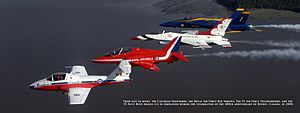
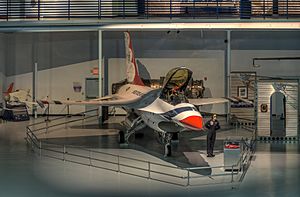
In 2008, the Thunderbirds remained in North America, performing both in the United States and in Canada. When Quebec City celebrated its 400th anniversary, the Thunderbirds joined the Canadian Forces's Snowbirds, the British Royal Air Force's Red Arrows, and the United States Navy's Blue Angels in a ceremonial flight over Quebec City. Later in the year, the team returned to Canada for two shows in Abbotsford, British Columbia.
In 2009 the Thunderbirds hired their first-ever Air National Guard pilot, Lt. Col. Derek Routt as Thunderbird No. 7 (operations officer), and the first-ever Reserve pilot, Maj. Sean Gustafson, also joined the team as Thunderbird No. 4 (slot).
The 2009 Far East Tour took the team to multiple locations on the western border of the Pacific Rim and included performances in Hawaii, Australia, Malaysia, Guam, Thailand, Japan, and South Korea. More than 1.2 million people saw the shows in person and more than 120 million were exposed to the shows through their national media. These are conservative estimates as one Korean prime-time television show alone reached eight million. The top-rated show "Qualifications of Man" did a one-hour feature on the Thunderbirds and resulted from a coordinated media pitch to the network and the Republic of Korea Air Force. In addition to the air shows, the Thunderbirds personally met and spent time with more than five hundred special needs children and orphans.
The entire 2013 flying season was canceled due to budget cuts resulting from the United States fiscal cliff. Team members made recruiting appearances in the Las Vegas area that did not require travel. Enlisted personnel performed gate checks and base housing inspections. Performances resumed in 2014.
Historical demonstration aircraft
- Republic F-84G Thunderjet
- Employed by the Thunderbirds 1953–1954.
- Republic F-84F Thunderstreak
- The Air Force selected the swept-wing F-84F Thunderstreak as their second aircraft in 1955, modified for the team by adding smoke tanks, and red, white and blue drogue parachutes. Used from 1955–1956.
- North American F-100C Super Sabre
- With the change to the F-100 Super Sabre in 1956, the Thunderbirds became the world's first supersonic aerial demonstration team. That same year, the Thunderbirds moved to Nellis Air Force Base, Nevada, simplifying logistics and maintenance for the aircraft. The Thunderbirds used the C-model Super Sabre from 1956–1963.
- Republic F-105B Thunderchief
- Only six shows were flown in 1964 using the F-105 before safety concerns resulted in the team's adoption of the F-100D.
- North American F-100D Super Sabre
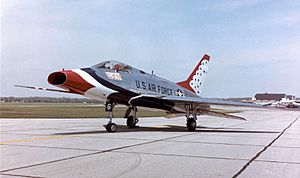
- The D-model Super Sabres were used from 1964–1968.
- McDonnell F-4E Phantom II
- The 1969 conversion to the F-4 was the most extensive in the team's history. Among other modifications, paints that had worked on the F-100 appeared blotchy on the F-4 because of multicolored alloys used to resist heat and friction at Mach 2 speeds. A polyurethane paint base was developed to resolve the problem. The white paint base remains a part of today's Thunderbird aircraft. A popular myth is, given the exhaust emissions of the F-4's engines, the vertical stabilizer of the No. 4 slot aircraft was painted flat black. However, this is false; the vertical stabilizer of the No. 4 slot aircraft was allowed to be blackened by jet exhaust starting in 1960. Phantoms were used from 1969 to 1973.
- Northrop T-38 Talon
- The fuel crisis of the early 1970s resulted in the selection of the Northrop T-38A Talon, a supersonic trainer. Five T-38s used the same amount of fuel needed for one F-4 Phantom, and fewer people and equipment were required to maintain the aircraft. Although it met the criteria of demonstrating the capabilities of a prominent Air Force aircraft, the Talon failed to fulfill the Thunderbird tradition of flying front-line jet fighters. The team flew the Talon from 1974–1981.
Relationship to other USAF aerial demonstration teams

The first USAF jet-powered aerobatic demo team was the "Acrojets", performing early in 1949 with F-80Cs at the USAF Fighter School at Williams Air Force Base, Arizona, and was headed by Col (then Capt) Howard W. "Swede" Jensen. This team flew together until August 1950, when it was inactivated due to the American commitment to the Korean War. Additionally, there was also a later USAFE "Acrojets" team in Germany, this one made up of USAF T-33 Shooting Star instructor pilots at Fürstenfeldbruck AB in the mid-1950s.
The "Skyblazers" were the USAF demonstration team representing the United States Air Forces Europe (USAFE) from the late 1940s through the 1950s. This team was formed in early 1949 by a group of 22d Fighter Squadron pilots from the 36th Fighter Wing at Fürstenfeldbruck Air Base in Germany. At this time they were flying Lockheed F-80B Shooting Stars. The unit transitioned to the F-84E in 1950, the F-86F in 1955 and the F-100C in 1956. Two of the original Skyblazer team members, identical twins C.A. "Bill" and C.C. "Buck" Pattillo, went on to become members of the first Thunderbird team.
Unlike the Thunderbirds, the Skyblazers seldom appeared outside of the realm of USAFE operations in Europe. The Skyblazers were disbanded in January 1962 when their home squadron was rotated back to the United States and their assigned aircraft transitioned to the F-105 Thunderchief.
The "Four Horsemen of the Apocalypse" were a group of four C-130 pilots and their planes who were officially recognized as an aerial demonstration team by the USAF's Tactical Air Command in 1957. They flew as an aerial demonstration team until 1960.
Thunderbirds museum
The Air Force maintains a Thunderbirds Museum covering the history of the demonstration team. The museum is located at Nellis Air Force Base and includes a full size F-16 "Gate Guard" on display (in full Thunderbird paint scheme).
Decorations
- Decorations

- Air Force Outstanding Unit Award
- 25 Feb 1967 – 31 Dec 1968; 1 Jan – 31 Dec 1973; 1 Jan – 31 Dec 1974; 1 Jan 1979 – 31 Dec 1980; 1 Jun 1995 – 31 May 1997; 1 Jun 2001 – 31 May 2003; 1 Jun 2004 – 31 May 2006

- Air Force Organizational Excellence Award
- 1 Jan 1984 – 31 Dec 1985; 1 Jan 1986 – 31 Dec 1987; 30 Sep 1989 – 30 Sep 1991; 1 Jun 1997 – 31 May 1998
Lineage
- Organized as: 3600th Air Demonstration Team, 25 May 1953
- Inactivated on 23 June 1956
- Organized as: 3595th Air Demonstration Flight, 19 November 1956
- Re-designated: 4520th Air Demonstration Flight, 1 July 1958
- Re-designated: 4520th Air Demonstration Squadron, 1 January 1961
- Discontinued on 25 February 1967
- Constituted as: USAF Air Demonstration Squadron, and activated 13 February 1967
- Organized on 25 February 1967
- Consolidated on 19 September 1985 with 30th Bombardment Squadron (Heavy), first organized on 13 June 1917
Assignments
4520th Air Demonstration Squadron
- 3600th Fighter Training Wing, 25 May 1953 – 23 June 1956
- USAF Advanced Fighter School, 19 November 1956 – 25 February 1967
USAF Air Demonstration Squadron
- Tactical Air Command, 13 February 1967
- USAF Tactical Fighter Weapons Center, 25 February 1967
- 57th Fighter Weapons (later, 57th Tactical Training; 57th Fighter Weapons; 57th Fighter; 57th) Wing, 15 February 1974 – present
Stations
4520th Air Demonstration Squadron
- Luke AFB, Arizona, 1 November 1952 – 23 June 1956
- Nellis AFB, Nevada, 19 November 1956 – 25 February 1967
USAF Air Demonstration Squadron
- Nellis AFB, Nevada, 25 February 1967 – present
Aircraft
4520th Air Demonstration Squadron
- Republic F-84G Thunderjet, 1953
- Republic F-84F Thunderstreak, 1954–1955
- North American F-100 Super Sabre, 1956–1963
- Republic F-105 Thunderchief, 1964
- North American F-100 Super Sabre, 1964–1966
USAF Air Demonstration Squadron
- North American F-100 Super Sabre, 1967–1968
- McDonnell-Douglas F-4 Phantom II, 1969–1973
- Northrop T-38 Talon, 1974–1982
- General Dynamics F-16 Fighting Falcon, 1983–present.
Notable members
Below are some of the more notable members of the Thunderbirds:
- Sam Johnson, American politician and military pilot
- Nicole Malachowski, American aviator and first female member of the Thunderbirds
- Merrill McPeak, Air Force General and pilot
- Michelle Curran, Air Force pilot and fifth female Thunderbird pilot
See also
 In Spanish: USAF Thunderbirds para niños
In Spanish: USAF Thunderbirds para niños


